
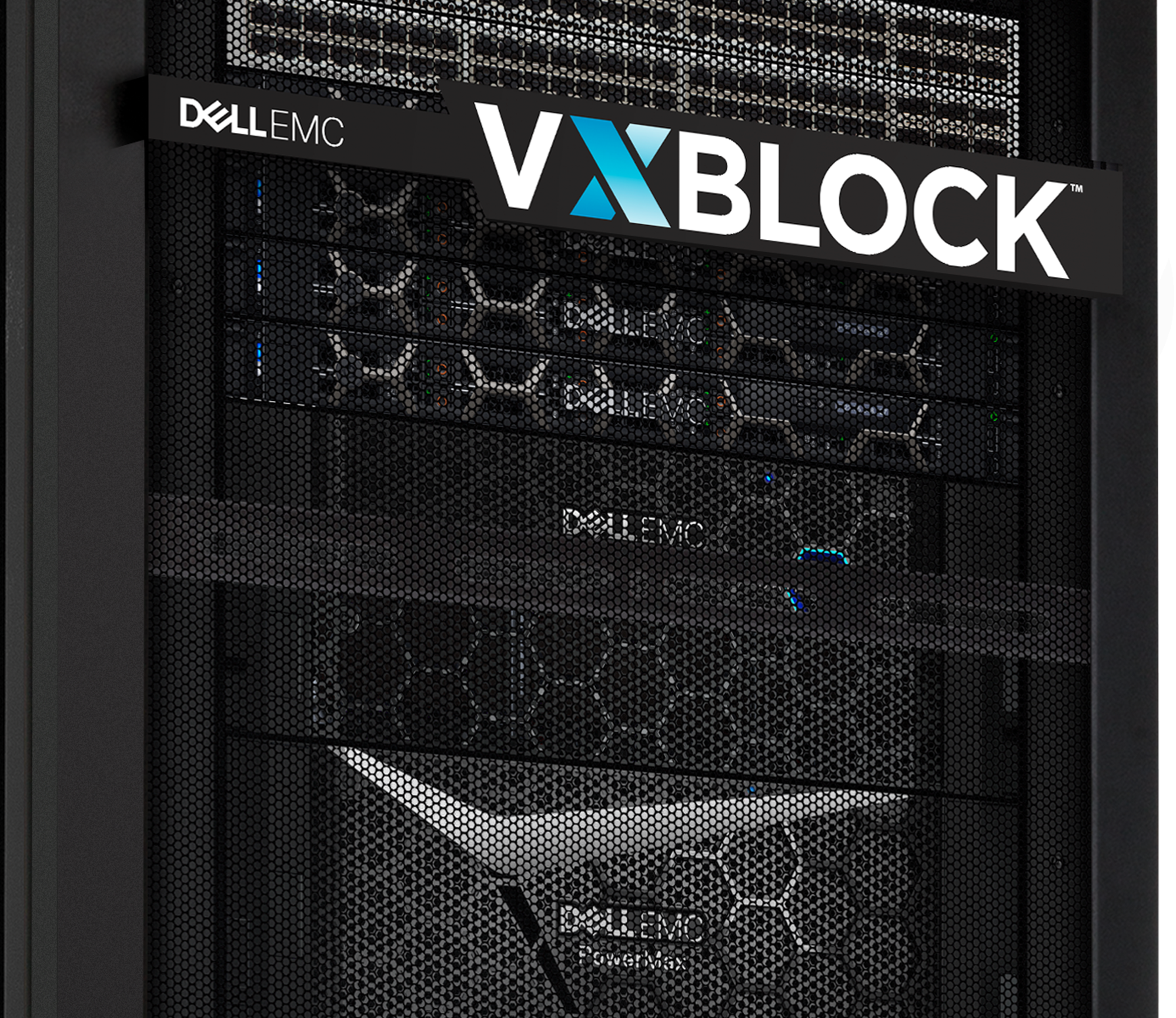
Dell EMC VxBlock 1000: Some history and What’s New
Thu, 13 Aug 2020 23:07:55 -0000
|Read Time: 0 minutes
First for the “some history” part! Converged Infrastructure (CI) is not a new concept – it’s been with us for more than 10 years. Hey, one could even consider that we were the “inventors” of CI back in the days when we publicly announced it on November 03, 2009 (Press Release).
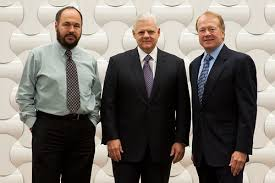
Figure 1. EMC Joe Tucci (center) unveils the Virtual Computing Environment coalition with VMware's Paul Maritz (left) and Cisco's John Chambers (right).
Nowadays the CI concept is well understood, but in 2009 it was kind of ground breaking since this approach had never been taken before.
“All datacenter requirements in just one system? How could that be possible?”
Those were the days of separated, disconnected, and siloed domains (compute, storage, networks) and CI was a new disruptive technology solution that would require a complete transformation in how IT would architect and consume datacenter infrastructure.
To have a clearer understanding of how Dell Technologies comprehends CI – then and now, we could define our CI end-to-end engineered turnkey system as:
VxBlock 1000, Industry-leading Converged Infrastructure, simplifies all aspects of IT by seamlessly integrating all the compute, network, storage and data protection and cloud management technologies you need into one engineered system. It is an all-in-one, “data center in a box.” You can offload the complexities and risks associated with managing enterprise-grade data center infrastructure so that your IT teams can confidently focus on higher-value activities. (from Top Reasons Why Organizations Choose VxBlock 1000 Converged Infrastructure).
For those new to VxBlock 1000, here are some of the most important values VxBlock has provided:
- High availability & data protection
- No single point of failure
- High availability in all components, fault tolerance as an option
- Broad data protection suite
- High scalability & consistent performance
- 100+ PB storage
- 1000+ blade & rack servers
- Scale-up & scale-out, symmetrically or asymmetrically
- NVMe end-to-end
- Rich data services & highest efficiency
- In-line, all-the-time services
- Compression, de-dupe, replication, encryption, copy data management & machine learning
- Cloud operating model & converged management
- Tight VMware vRealize Integration
- Consistent tool set across hybrid cloud
And what has happened during this 10+ year period?
Many things. Many milestones. Many systems sold. Many successful customer stories and projects that have led VxBlock to a very effective and consistent $1 billion annual run rate business just four years into its existence. Check the diagram below to reflect on some of the key milestones VxBlock and Dell Technologies CI as a whole have delivered during this decade.
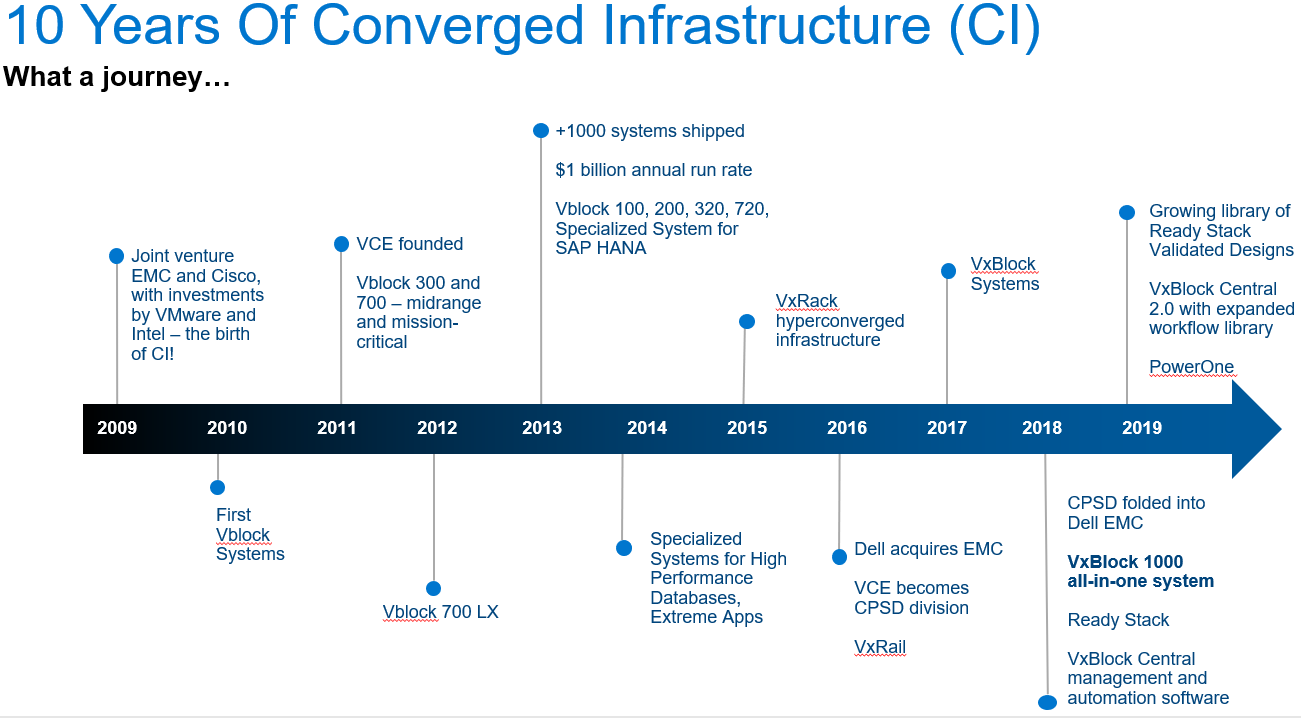
Figure 2. VxBlock 1000 one-decade journey
Today, with more than 4500 systems installed in over 100 countries, VxBlock 1000 keeps on leading the way, innovating the CI arena in four key areas that address the second part of this blog post, namely “What’s New”:
- Flexible technology choices
- Converged management and automation
- Life cycle management
- Future proof design and support
Flexible technology choices
VxBlock System 1000 gives you a choice of industry-leading technologies to meet the needs of all your different workloads, ranging from mission-critical, general purpose (virtualized or not), Artificial Intelligence/Machine Learning, End User Computing/Virtual Desktops… you name it!
Mix and match powerful Dell EMC storage and data protection options, Cisco UCS blade and rack servers, Cisco LAN and SAN networking, and VMware virtualization and cloud management. For more details on infrastructure see VxBlock 1000 data sheet and specs.
Since VxBlock 1000 is not just a reference architecture or a bill of materials, it eliminates the traditional risks associated with “Do It Yourself” approaches. It’s a fully integrated system that is engineered, manufactured, managed, supported, and sustained as one product, delivering a turnkey experience. Dell Technologies validates interoperability of components and provides a predictable system maintenance process that improves availability and productivity.
Converged management and automation
VxBlock 1000 leverages its deep VMware integration to simplify automation of everything from daily infrastructure provisioning tasks to delivery of IaaS and SaaS. At the foundation is VxBlock Central software that provides a single unified interface and access point for converged infrastructure operations.
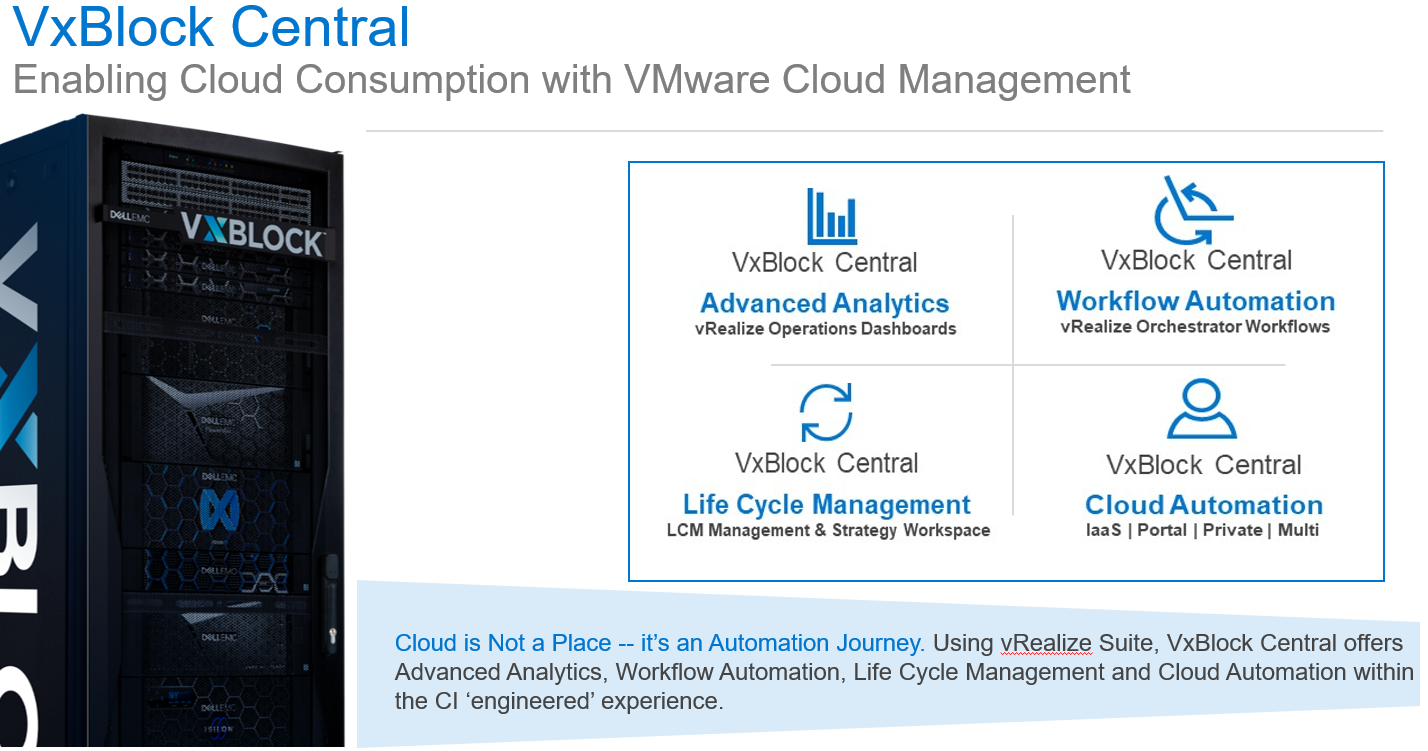
Figure 3. VxBlock Central, a single pane of glass for management, automation, and LCM
VxBlock Central software dramatically simplifies daily administration by providing enhanced system-level awareness, automation and analytics, including launch points to:
- VMware vRealize Orchestrator (vRO) with workflows for automating daily operational tasks
- vRealize Operations (vROps) for deep VxBlock analytics and simplified capacity management
As customers place workloads on top of VxBlock 1000, VxBlock Central helps to provide and maintain these services by managing the infrastructure underneath. See here for more great info about VxBlock Central Workflow Automation and the 40+ workflows available in the Workflow Automation Library.
Life cycle management
Dell EMC CloudIQ for VxBlock features next-generation lifecycle management (LCM) that enables IT teams to more flexibly plan ahead and control converged hardware lifecycle, further reducing risk with proactive SaaS-based insights. You gain granular control over hardware inventory, milestones, support interoperability, and upgrade scenarios.
Future proof design and support
VxBlock 1000 is built with a perpetual design, meaning it will ensure that your system stays ready to support the introduction of next-generation technologies within any of the fundamental domains of the system, whether storage, compute, or network. You can address increased performance and scalability requirements while maximizing the return on your system investment.
Dell Technologies delivers fully integrated 24/7 support with a single call. There’s never any finger-pointing between vendors. You can always rely on our fully cross-trained team for a fast resolution to any problem. Our portfolio of services (including deployment services, migration services, and residency services) accelerates speed of deployment and integration into your IT environment. It also minimizes downtime by ensuring your software and hardware remains up to date throughout the product lifecycle.
Wrapping up
One decade ago, Dell Technologies defined the foundations for CI and created a platform that has evolved to what today is VxBlock 1000. This system (compute, network, storage and management layer) is created (engineered and manufactured), maintained (single management and support), and sustained (in ongoing certified code upgrades) by Dell EMC during its entire journey. Customers simply take the keys of the car and drive.
Ignacio Borrero - LinkedIn, Twitter: @virtualpeli
Related Blog Posts

Introducing new Converged Management Software with CloudIQ for VxBlock Systems
Thu, 16 Dec 2021 19:53:16 -0000
|Read Time: 0 minutes
We are delighted to announce that today, our new Converged Management Software (CMS) for VxBlock System 1000, VxBlock System 740, VxBlock System 540, and VxBlock System 350 is available. CMS is an exciting new product that provides a unified CloudIQ integrated management for Converged Infrastructure (CI) operations for VxBlock. It dramatically simplifies daily administration by providing enhanced system-level awareness, automation, and analytics. CMS replaces VxBlock Central, and VxBlock Central software is no longer available with new VxBlock Systems.
What is CMS?
CMS is a lightweight on-prem software that provides VxBlock system configuration and data discovery. CMS collects the required management data from different components within your VxBlock system and sends it to CloudIQ, a single pane of glass management dashboard for VxBlock operations for processing and analytics. With CMS, you can consolidate management and monitoring of VxBlock systems with other Dell Technologies infrastructure solutions through CloudIQ.
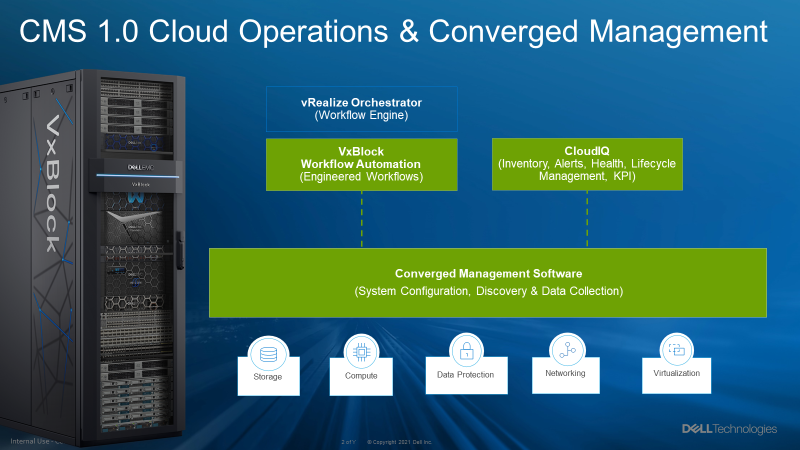
8 Fun-Facts about CMS:
- CloudIQ conveniently unifies the management dashboard for VxBlock systems and other Dell infrastructure products
- Deployment and system configuration time is drastically reduced with simplified on-prem CMS software
- Asset management for compute, storage, and virtualization in the context of converged infrastructure inventory allows for simplicity
- Greater visibility into lifecycle milestones for components in the converged systems for better TCO management
- Efficient monitoring of the status of service contracts for exceptional Dell support
- Automation workflows to expand compute and storage resources more quickly and systematically
- Deep KPI metrics including capacity reporting and performance analytics with historical perspective for storage devices when onboarded within CloudIQ
- Comprehensive telemetry for efficient and streamlined support experience
Next Steps
Dell EMC’s latest Converged Management System (CMS) is now available and replaces VxBlock Central. CMS automates complex orchestration tasks and simplifies lifecycle management while enabling exceptional infrastructure visibility. Please use the following resources to learn more about the VxBlock systems and CloudIQ.
- Dell EMC and Partner FAQs: Converged Management Software 1.0 AND VxBlock Central End of Life
- VxBlock Product Page
- VxBlock Technical Collateral
- VxBlock Product Overview
- CloudIQ Product Page
- CIoudIQ Simulator
- Dell Technologies Document Center
Authors: Udit Sharma and Sameer Mohile

RecoverPoint for VMs Automation – Advanced VM Protection
Wed, 21 Feb 2024 21:39:22 -0000
|Read Time: 0 minutes
In the spirit of automating everything, this blog will discuss a new automation solution in the RecoverPoint for VMs (RP4VMs) collection of automation solutions.
We have a variety of automation solutions for RP4VMs, including per-tag and per-cluster VM protection and use-case driven tasks, as well as a complete deployment automation solution. Now, I would like to present a new automation solution – Advanced VM Protection.
Let’s take a closer look at this exciting new solution.
What does the solution do?
The RecoverPoint for VMs advanced VM protection solution automates VM protection in RP4VMs with a wide variety of options:
- Automates VM protection based on pre-defined parameters in a JSON configuration file:
- VM name
- RP4VMs cluster name
- Plugin server IP or FQDN
- vCenter user/password or path to credentials file
- Production journal capacity (GB)
- Replica journal capacity (GB)
- Required RPO (sec)
- Failover networks per vNIC
- Performs and monitors mass VM protection
- Protects VMs for a specific RP4VMs cluster (optional)
- Performs VM protection operations on a specific plugin server (optional)
- Includes an option to skip the monitoring of VM protection preparation tasks
- Configures failover networks on a per network adapter basis as a post-protection operation
What is the solution?
It is a Python-based script that exclusively leverages the RP4VMs REST API.
Here is the list of prerequisites:
- Python 3.x (The script supports every platform Python is supported on)
- Python requests module, which can be installed using pip with the command:
pip install requests or python -m pip install requests
- RP4VMs 5.3.x and later
- Connectivity from the host running the script to the RP4VMs plugin server(s), specifically on tcp port 443
How do I use the script?
The script accepts the following parameters:
- One mandatory parameter, file, for a full path to the JSON configuration file.
- The optional parameters, rpvmcluster and server, limit script execution only for VM protection on a specified RP4VMs cluster and/or plugin server accordingly.
- The no-monitor parameter skips monitors of VM protection preparation task.
Here is the full script syntax:
# python advprotectvm.py -h usage: advprotectvm.py [-h] -file CONFIG_FILE [-cl RPVM_CLUSTER] [-s SERVER] [-nmonitor] Scripts advanced VM Protection in RecoverPoint for VMs options: -h, --help show this help message and exit -file CONFIG_FILE, --vm-config-file CONFIG_FILE Path to VM config file -cl RPVM_CLUSTER, --rpvmcluster RPVM_CLUSTER Optionally specify the RP4VMs cluster -s SERVER, --server SERVER Optionally specify RP4VMs Plugin Server DNS/IP -nmonitor, --no-monitor Optionally prevents protection monitoring
Use Cases and Examples
Let’s look at some common use cases for RP4VMs automated advanced VM protection:
- RP4VMs mass VM protection for onboarding of a new application:
# python advprotectvm.py -file idan-vms.json
- Batch VM protection only for a specific RP4VMs cluster:
# python advprotectvm.py -file idan-vms.json -cl Tel-Aviv
- Mass VM protection for a specific vCenter/ plugin or onboarding of a new datacenter:
# python advprotectvm.py -file vms.json -s pluginserver.idan.dell.com
Script output
# python advprotectvm.py -file vms.json -> Protecting VM prodwebsrv1 ---> Protection of VM prodwebsrv1 initiated -> Protecting VM prodappsrv1 ---> Protection of VM prodappsrv1 initiated -> Protecting VM proddbsrv1 ---> Protection of VM proddbsrv1 initiated -> VM protection initiated, monitoring ---> Protection of VM: prodwebsrv1, Transaction: d6783e2d-55be-47db-a082-de1d251c2375, Status: RUNNING ---> Protection of VM: prodappsrv1, Transaction: 808ab022-e79a-4ad1-a633-cc86e17644f2, Status: RUNNING ---> Protection of VM: proddbsrv1, Transaction: c7895dce-f3e6-4e70-872e-9d0b104d6273, Status: RUNNING ---> Protection of VM: prodwebsrv1, Transaction: d6783e2d-55be-47db-a082-de1d251c2375, Status: RUNNING ---> Protection of VM: prodappsrv1, Transaction: 808ab022-e79a-4ad1-a633-cc86e17644f2, Status: RUNNING ---> Protection of VM: proddbsrv1, Transaction: c7895dce-f3e6-4e70-872e-9d0b104d6273, Status: RUNNING ---> Protection of VM: prodwebsrv1, Transaction: d6783e2d-55be-47db-a082-de1d251c2375, Status: RUNNING ---> Protection of VM: prodappsrv1, Transaction: 808ab022-e79a-4ad1-a633-cc86e17644f2, Status: RUNNING ---> Protection of VM: proddbsrv1, Transaction: c7895dce-f3e6-4e70-872e-9d0b104d6273, Status: RUNNING ---> Protection of VM: prodwebsrv1, Transaction: d6783e2d-55be-47db-a082-de1d251c2375, Status: COMPLETED ---> Protection of VM: prodappsrv1, Transaction: 808ab022-e79a-4ad1-a633-cc86e17644f2, Status: COMPLETED ---> Protection of VM: proddbsrv1, Transaction: c7895dce-f3e6-4e70-872e-9d0b104d6273, Status: COMPLETED -> Configuring failover networks ---> Skipping failover network config for VM: prodwebsrv1 ---> Failover networks config is not required for VM: prodappsrv1 ---> Failover network config is successful for VM: proddbsrv1
Where can I find it?
The script and the config file can be found on GitHub: https://github.com/IdanKen/Dell-EMC-RecoverPoint4VMs.
Resources
- The Dell developer site provides comprehensive online API documentation, including full API references, tutorials, and use cases for the RP4VMs REST API.
- The RP4VMs REST API offers self-documentation – Swagger UI running on the plugin server itself – https://{plugin-server}/ui
- RecoverPoint for VMs GitHub repository
- RecoverPoint for VMs 5.3 – New RESTful API Demo
How can I get help?
For additional support, you are more than welcome to raise an issue in GitHub or reach out to me by email: Idan.kentor@dell.com
Thanks for reading!
Idan
Author: Idan Kentor


